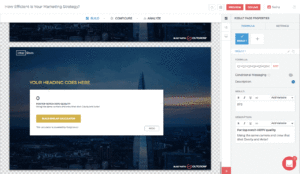How to Make a Viral Calculator?
Table of Contents
A recent research report by the Content Marketing Institute revealed that around 46% of marketers currently use interactive content. And what is even more amazing is that 79% of marketers are planning to use more of it in the coming years. Why? They feel this content form helps them engage the audience better and differentiate their brand. Creating brand awareness and lead generation are some other reasons they cite. But that’s about creating interactive experiences. What after that?
Once you’ve a calculator ready, the next focus should be to present it to the right audience by promoting it on the right channels. This can make your calculator go viral in no time. However, there’s more to the anatomy of a viral calculator.
We bring you 5 vital requirements that must be met to make your calculator go viral!
Related Read – Top 5 Viral Calculators that Broke the Internet
1. Add Real Value
The value of content marketing lies in the engagement between the customer and your company. Traditional advertising shouts at prospect customers whereas content marketing talks with them. Essentially, it is about the creation and participation in meaningful conversations and development of relationships…” – Amanda Maksymiw (@amandamaksymiw)
Blatantly selling your brand to the consumers is passe. You need to focus on adding value to them, providing answers to their most pressing questions, and engaging them in a dialogue. It is when you talk to the customers, rather than selling to them, that they are more likely to advocate your brand to the other prospects. This considerably increases the reach of your products or services.The same goes with the interactive experiences you create.
You must keep yourself in the shoes of your consumers and ask yourself questions like – is the calculator good? Is it solving the problems at hand? Will the results be of real value to the users? Is the content relevant and timely?
Ideate and create the calculator to solve a real problem. Take this calculator, for instance. It helps users find out how many more leads they can generate when they switch to interactive content marketing.
2. Answer Questions People Have
Calculators are meant to resolve the issues which come up in your prospects’ everyday lives. They come handy in situations where there is no black or white, no right or wrong!
As the prospect goes through the different stages of a funnel, he/she may have different questions about the problem at hand. For prospects in the awareness stage, a Top of the Funnel “ToFu” strategy is required, where instead of directly selling, you educate the customers and generate interest. Here, you can create a calculator that gives them general awareness about your value proposition. For instance, if you’re a content marketing agency, you can use this calculator to help prospects better understand content distribution.
Similarly, at MoFu (Middle of the Funnel), budget is a primary concern for most of the people. So, you can create a cost calculator for your prospects. This helps in getting the conversion rate high as prospects start showing trust on you and they have been informed well. VenturePact, a software development marketplace, developed a Mobile App Cost Calculator which helped their customers to define the budget of their apps based on a set of questions. No doubt why it went viral and got them more than 11,000 qualified leads in just over 2 weeks!
Moving further, to the bottom of the funnel (BoFu), while you can talk about your product, you should never undermine the ultimate objective of education. An ROI calculator is ideal at this stage. It helps your prospects decide between you and your competitors and make a purchase decision. The objective is to increase your conversion rate. We created one at Outgrow!
3. Design It to be Share Worthy
The User Interface (UI) is the point at which users interact with the calculator and thus, it must be neat. Its flow should be logical, the design responsive, and above all, it should be easy to use. Besides, you shouldn’t hesitate from using images, GIFs, and infographics within your calculator. They bring out the necessary interactivity, which increases the attention span. Research also supports that!

4. Use Comparisons Rather than Showing Plain Results
Remember those boring physics classes where they talked about the function of a circuit, but you won’t even understand where the positives or negatives would go on the circuit board? Until the lab sessions happened of course! The circuit board was built right in front of your eyes and results were demonstrated practically. The point? Your prospects are ‘you in the Physics class’ and the calculator results are ‘the circuit boards built during lab sessions’. They would understand the results even if you just wrote plain text and numbers, but won’t quite relate to them.
Thus, it becomes important to add comparison charts, graphs and other demonstrations in your results. The results should be shown in such a way that the user feels excited about them. Consider the example of the Venturepact mobile app cost calculator. The calculator went viral and got the brand 15% more traffic and 11,000 leads with a 28% conversion rate. The comparative results for pricing for different time zones, in the end, gave prospects deeper insights, thus engaged them better.
5. Add a Touch of Personalization
Calculators take inputs from the users and give them answers based on their responses. What makes it super cool is that it happens in real time and customers feels that it was meant for them. Thus, they feel like sharing it in their network.
Customization and personalisation are the keys to add value to your calculator. They help you build-in virality in your calculator by personalizing the questions and results. For example, Logic Jump, a feature available in Outgrow makes calculators more intelligent and personalized. Lets for say you are making a Cancer Risk Calculator, there can be a situation where the next question depends on the answer given for the present question. If you ask whether they smoke or not, then in case of Yes, you would want to ask “When did they start smoking>” and in case of NO a question like “When did they quit?”. This helps you know the user better and correct answers produced can help customers make good choices and get better results.

Creating interactive experiences is great for your marketing strategy, however, if people don’t use them, the whole point of creating them is defeated. Thus, you must consider the aforementioned points when creating a calculator, to ensure it has virality built-in.
Antara Agarwal is a full time marketing consultant at Outgrow. She can be found packing her bags for her next trip, often to the mountains. And in one of those bags you will always find a half finished book she’s been struggling with for months.



